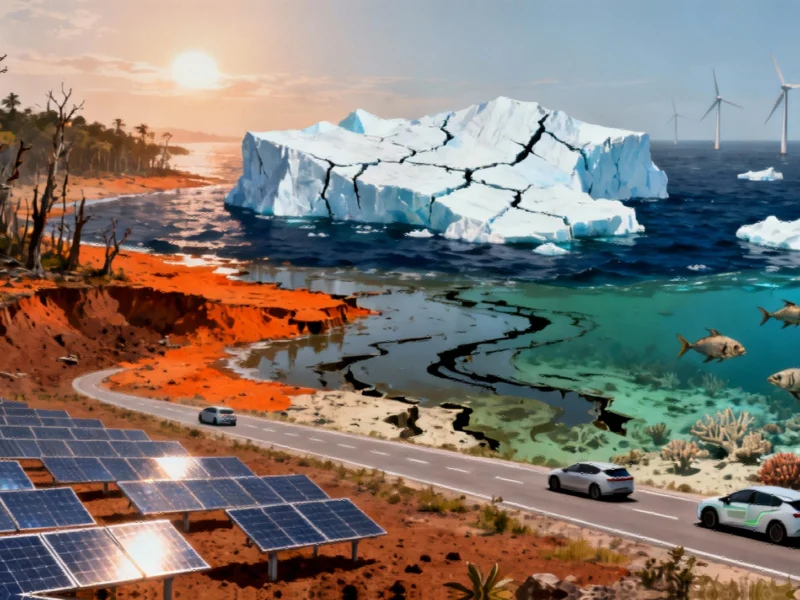A new scientific report reveals that Earth’s climate systems are approaching irreversible thresholds, with some tipping points potentially already crossed. As global temperatures continue rising, large swaths of the planet could undergo dramatic transformations that would fundamentally reshape ecosystems and human societies. The findings come just weeks before world leaders convene at the COP30 climate conference in Brazil, where urgent action will be demanded to prevent catastrophic climate shifts.
According to the comprehensive analysis, Earth has warmed approximately 1.4°C since the Industrial Revolution, pushing us dangerously close to the 1.5°C limit established in the 2015 Paris Agreement. Researchers warn that breaching this threshold isn’t merely symbolic but could trigger cascading environmental changes. As climate tipping points accelerate, the stability of global systems hangs in the balance, requiring immediate policy interventions and technological solutions.
The Tipping Point Landscape
The report identifies multiple critical thresholds that could be crossed as temperatures rise. Coral reef ecosystems, which support up to 40% of marine life and generate trillions in economic value through tourism and fisheries, have likely already passed their tipping point at 1.2°C warming. The current global bleaching event, affecting nearly 85% of reefs since 2023, represents what could become permanent loss by 2100 without dramatic intervention.
Other imminent tipping points include the collapse of major ice sheets and ocean currents. The melting of glaciers and polar ice could lock in significant sea level rise, while the potential shutdown of the Atlantic Meridional Overturning Circulation (AMOC) threatens catastrophic climate disruption across Europe and North America. This current system regulates temperatures and stabilizes nearly half of other known tipping points, making its potential collapse particularly concerning.
Cascading Effects and Domino Dynamics
Climate scientists emphasize that tipping points don’t operate in isolation. Instead, they function like dominoes – when one falls, it increases the likelihood of others triggering. The melting of permafrost, for instance, releases ancient stores of carbon dioxide and methane, accelerating global warming and making additional tipping points more probable.
Professor Tim Lenton, who leads the Global Systems Institute at the University of Exeter and headed the report, explains the urgency: “We are rapidly approaching multiple Earth system tipping points that could transform our world, with devastating consequences for people and nature. This demands immediate, unprecedented action from leaders at COP30 and policymakers worldwide.”
The interconnected nature of these systems means that addressing them requires sophisticated approaches. As highlighted in recent complexity economics research, traditional linear models may be insufficient for understanding these cascading effects.
Positive Tipping Points Offer Hope
Despite the grim projections, the report identifies promising “positive tipping points” in clean energy adoption that could help avert disaster. Solar power capacity is currently doubling every two to three years, driving down costs and making renewable energy increasingly accessible. Similarly, electric vehicle adoption continues to accelerate globally.
These technological shifts are creating virtuous cycles. As solar panels become more widespread, investment in battery storage technology has surged, with prices falling 84% over the past decade while capacity has dramatically increased. This renewable energy revolution mirrors technological breakthroughs seen in other fields, such as the chemical anomalies discovered on Titan that could inform our understanding of planetary systems.
The Governance Challenge
Current climate policies often fail to account for tipping point dynamics, according to report co-author Dr. Manjana Milkoreit from the University of Oslo. “Tipping points present distinct governance challenges compared to other aspects of climate change or environmental decline,” she notes, “requiring both governance innovations and reforms of existing institutions.”
The computing and technology sectors are demonstrating how rapid transformation is possible. Just as Microsoft PowerToys updates deliver automated theming that improves user experience, climate solutions need to become more integrated and automated to achieve necessary scale.
Pathways to Prevention
The report calls for accelerated investment in sustainable technologies that are nearing their own positive tipping points. Home heat pumps, greener agricultural practices, and other innovations could soon reach critical mass where high demand drives further innovation and cost reductions.
Technology partnerships are proving crucial in this transition. Similar to how Nvidia and Infineon partnered for AI data center power optimization, cross-sector collaborations can accelerate climate solutions. The computing industry’s progress, including Linux 6.18 performance enhancements with Intel processors, demonstrates how rapid innovation can occur when multiple stakeholders align.
Even entertainment and media partnerships, like the Apple and Peacock streaming collaboration, show how industries can transform through strategic alliances – a model that could benefit climate action efforts.
The COP30 Imperative
With the November summit approaching, scientists are working with conference leaders to ensure tipping points feature prominently on the agenda. The two years since the first Global Tipping Points Report have seen “radical global acceleration” in some areas, particularly renewable energy adoption, but researchers stress that current progress remains insufficient.
“We need to do more – and move faster – to seize positive tipping point opportunities,” Professor Lenton emphasizes. “By doing so, we can drastically cut greenhouse gas emissions and tip the world away from catastrophic tipping points and towards a thriving, sustainable future.”
The coming months will determine whether global leaders can harness both the warning signs and the opportunities identified in the report to enact the systemic changes needed to preserve Earth’s critical systems.
Based on reporting by {‘uri’: ‘phys.org’, ‘dataType’: ‘news’, ‘title’: ‘Phys.org’, ‘description’: ‘Phys.org internet news portal provides the latest news on science including: Physics, Space Science, Earth Science, Health and Medicine’, ‘location’: {‘type’: ‘place’, ‘geoNamesId’: ‘3042237’, ‘label’: {‘eng’: ‘Douglas, Isle of Man’}, ‘population’: 26218, ‘lat’: 54.15, ‘long’: -4.48333, ‘country’: {‘type’: ‘country’, ‘geoNamesId’: ‘3042225’, ‘label’: {‘eng’: ‘Isle of Man’}, ‘population’: 75049, ‘lat’: 54.25, ‘long’: -4.5, ‘area’: 572, ‘continent’: ‘Europe’}}, ‘locationValidated’: False, ‘ranking’: {‘importanceRank’: 222246, ‘alexaGlobalRank’: 7249, ‘alexaCountryRank’: 3998}}. This article aggregates information from publicly available sources. All trademarks and copyrights belong to their respective owners.
